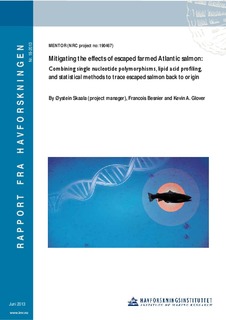| dc.contributor.author | Skaala, Øystein | |
| dc.contributor.author | Besnier, Francois | |
| dc.contributor.author | Glover, Kevin A. | |
| dc.date.accessioned | 2013-07-09T12:32:01Z | |
| dc.date.available | 2013-07-09T12:32:01Z | |
| dc.date.issued | 2013-06 | |
| dc.identifier.issn | 1893-4536 | |
| dc.identifier.uri | http://hdl.handle.net/11250/116786 | |
| dc.description | MENTOR (NRC project no: 190467) | no_NO |
| dc.description.abstract | Comparisons between 300 polymorphic SNPs and 14 short tandem repeats (STRs) were
conducted on a data set consisting of approximately 500 Atlantic salmon arranged in 10
samples/populations. Global FST ranged from 0.033-0.115 and -0.002-0.316 for the 14 STR
and 300 SNP loci respectively. The best 15 SNPs (30 alleles) gave a similar level of selfassignment
to the best 4 STR loci (83 alleles), however, addition of further STR loci did not
lead to a notable increase assignment whereas addition of up to 100 SNP loci increased
assignment.
In 2003, a common garden experiment was initiated in the Guddal river to evaluate and
compare the performance of Farm, Wild and Hybrid Salmon in the river habitat. Significant
differences in growth, body shape (condition factor) and mortality were reported between
these three types (Skaala et al. 2012). The aims of this two years post-doctoral project was to
provide better understanding on the genetic bases for the observed differences in growth,
body shape and mortality between wild, farm, and hybrid salmon. Genome scan for QTL
affecting length (L), weight (W), and condition factor (CF) revealed several genomic regions
significantly affecting these three phenotypes. The genomic positions of these QTL as well as
proportion of the trait variance explained are identified.
Weight is significantly affected by two QTL: one on chromosome 2 that explains 8.4% of the
observed weight variance in our population, and one on chromosome 11 responsible for 7.7%
of observed weight variance. Collectively, these two QTL are responsible for 14.8% of the
weight variance.
QTL position on chromosome 2 appears to be a particularly interesting region that both
affects growth and survival in the river habitat. Moreover, this genomic region displays a
strong reduction in genetic variability in the farm population whereas genetic variability is
still very high in the wild population. QTL on chromosome 2 appears thus to be a genomic
region potentially bearing the footprint of ongoing domestication in salmon. This study
represents the first investigation into the genetic architecture underlying the relative
performance of farmed and wild Atlantic salmon in the natural habitat. | no_NO |
| dc.language.iso | eng | no_NO |
| dc.publisher | Havforskningsinstituttet | no_NO |
| dc.relation.ispartofseries | Rapport fra Havforskningen;Nr. 18-2013 | |
| dc.subject | farmed fish escape | no_NO |
| dc.subject | fiskerømning | no_NO |
| dc.title | Mitigating the effects of escaped farmed Atlantic salmon: Combining single nucleotide polymorphisms, lipid acid profiling, and statistical methods to trace escaped salmon back to origin | no_NO |
| dc.type | Working paper | no_NO |
| dc.subject.nsi | VDP::Agriculture and fishery disciplines: 900::Fisheries science: 920::Aquaculture: 922 | no_NO |
| dc.source.pagenumber | 11 s. | no_NO |
